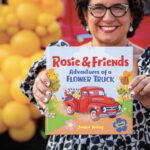It’s 11:35 p.m., Wednesday, December 7, and I haven’t left home at this odd of a weekday hour since Black Friday. I bend over my steering wheel and crane my neck toward the sky: still no snow. Front Street is as clear as a country road, a sleek, damp ribbon studded with lamp posts. The black jogging path runs beside a silver Susquehanna. It’s a picturesque scene, but the weather forecast has been clear: snow advisory for central Pennsylvania from 7 p.m. to 7 a.m. Thursday.
When snow is in the forecast, most of us slide into a familiar routine: check the quantity of milk in the fridge, the level of gas in the tank. The routine typically stops there, except for the occasional glance at the sky. This is not the case of Harrisburg’s Department of Public Works, for whom the term “snow day” has an entirely different meaning.
Tonight, four men—Dave Spiroff of Enola, Rodney Keller of Hummelstown, Randy Sauder of Harrisburg and David Jordan of Susquehanna Township—have just arrived for work. I join them in a utility building on S. 19th Street, which is backlit by fog and orange light. Director Ernie Hoch sips coffee and shakes my hand, and the men greet me with a nod. “This is my ‘A’ team,” said Hoch, by way of an introduction. “These are the guys that I call first.”
During heavy snow, as many as 45 men, CDL-licensed or otherwise, can be called upon by the department to help clear the streets, rotating over 12-hour shifts. Most snow removal strategies are systematic, including prioritizing primary and secondary streets and mapping out the city into eight sections to focus the work. However, trying to determine where to push the snow, or struggling to fit a snowplow down narrow Penn Street, can make for white-knuckle work.
“There’s always that one street you’re driving down with your heart pumping Kool-Aid,” said Spiroff, who has worked with the city for 16 years.
Tonight, expectations are minimal. The 1- and 5-ton salt trucks have already been loaded, the goal being to salt ramps and bridges and to keep a close eye on the roads near the river, where it’s colder. The crew scatters, taking places among the city.
Hoch and I duck into a pick-up truck and drive up Cameron Street. We’ve barely driven five minutes before Hoch checks the weather on his phone. “I actually think the snow’s passed over us,” he said suddenly. There is no regret in his voice. “I’m not disappointed. It’s better to be proactive. The streets will be clear by rush hour.”
I will be awake again by 6:30 a.m. and part of that rush hour traffic that will move swiftly through a bitter cold sunrise. The students that I teach will be disappointed to have not had a delay, and I will secretly regret that I can’t sleep in, either. However, it’s clear that this privilege of safe driving has everything to do with the four trucks that are out on the streets right now, circulating like quiet watchmen, tracing the city silently beneath a snow-less sky.





